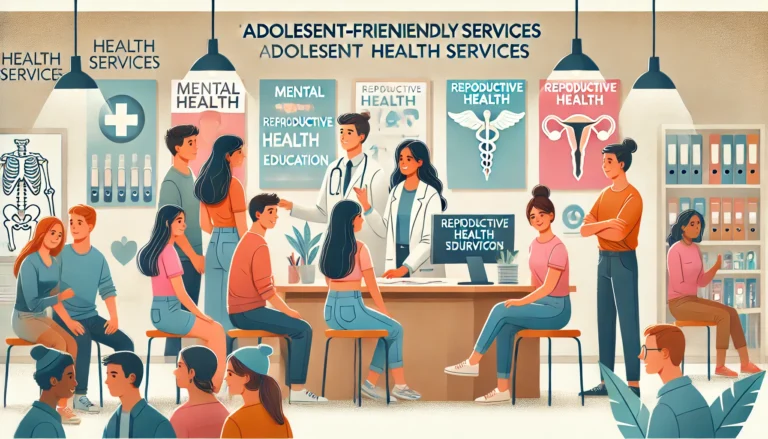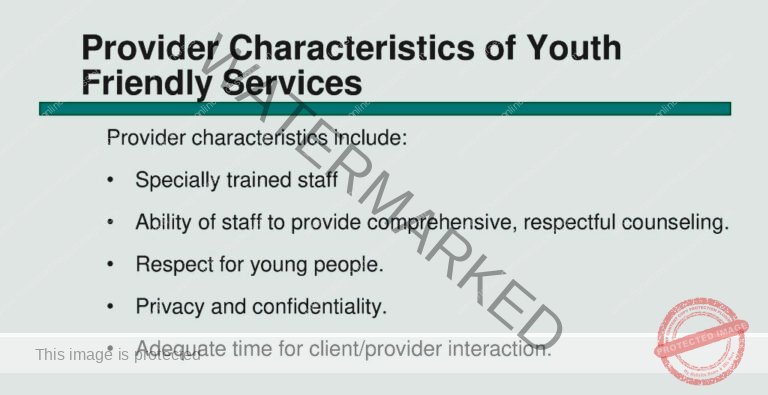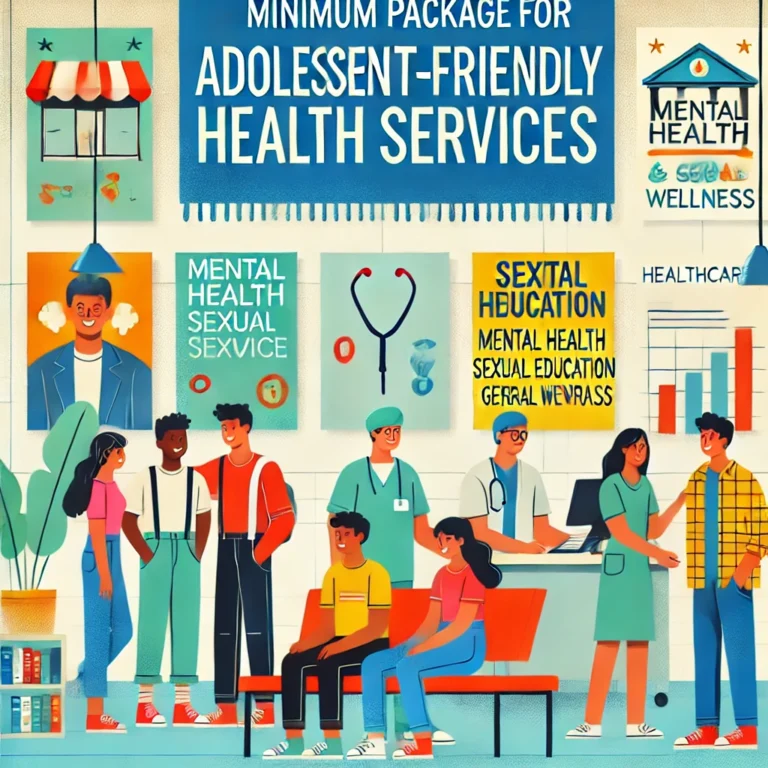Adolescent Reproductive Health
Subtopic:
Adolescent-Friendly Health Services

Adolescent-Friendly Health Services are defined as health services intentionally designed to be easily reachable geographically, financially within reach, culturally appropriate, welcoming in nature, and most importantly, guaranteeing privacy for young people.
These specialized services are specifically tailored to address the unique health requirements of adolescents, particularly focusing on their sexual and reproductive health. They typically encompass a range of support, including guidance and advice, access to contraception, care following abortion, voluntary counselling and testing (VCT), and information and management of sexually transmitted infections (STIs), including referral pathways to specialist services.
Adolescents encounter a multitude of health challenges, especially concerning their reproductive well-being. These challenges prominently include:
Pregnancies at a young age or when not desired
Abortion procedures carried out unsafely
Infections transmitted sexually, including HIV/AIDS
Harmful practice of female genital mutilation
Difficulties related to mental and emotional health
Misuse of drugs and alcohol
Experiences of sexual violence and exploitation
These significant issues can lead to serious negative consequences for adolescents, such as dropping out of education or living a life that is compromised and precarious, both during their teenage years and into adulthood.
It is crucial to connect adolescents and young individuals with Adolescent-Friendly Health Services (ADFHS) to effectively address the numerous health problems and risky behaviours they face. This outreach must be implemented in a way that guarantees availability and ease of access for all young people, including those in conflict zones and areas that are difficult to reach.
Factors Restraining Adolescents from Accessing Adolescent-Friendly Health Services (ADFHS)
High Cost of Health Care: The financial burden of healthcare can make services less obtainable for young people.
Long Distances to Health Units: Significant distances, particularly in less populated regions, can create physical obstacles to reaching healthcare facilities.
Poor Access to Information: A scarcity of reliable health information limits the ability of adolescents to make well-informed choices.
Poor Transport and Communication Systems: Deficiencies in infrastructure,can hinder travel to health facilities and access to information about available services.
Poor Staffing at Service Points: Low numbers of staff can cause extended wait times and a decline in the standard of care.
Negative Attitudes and Behaviours of Health Staff: Unwelcoming behavior from healthcare workers can deter young individuals from seeking help, especially for sensitive health matters.
Lack of Confidentiality: Apprehensions regarding potential privacy violations can dissuade adolescents from utilizing available services.
Lack of Parental Support: Young people may encounter difficulties in obtaining services if they lack the backing or awareness of their parents/guardians.
Scarcity of Adolescent-Friendly Services: An uneven service distribution, for example , concentrated services in urban areas ,will limit accessibility to those in rural places.
Lack of Confidence in Services: Uncertainty regarding the quality of services may contribute to reluctance in seeking healthcare.
Shortage of Health Education (IEC): Limited health education can lead to decreased awareness of health services and associated topics.
Chronic Shortages of Supplies: Restricted access to key supplies,can hinder comprehensive care.
High-Risk Behaviours: Involvement in risky activities creates complex challenges.
Harsh Socio-economic Conditions: Factors such as poverty, , and lack of education can increase school dropout rates and illiteracy, particularly for girls.
Cultural Barriers: Deep-seated cultural norms may conflict with modern healthcare practices, causing opposition.
Stigma and Discrimination: Concerns about judgment may prevent adolescents from accessing healthcare.
Legal Restrictions: Restrictions related to age or legal status may limit adolescents’ independence in accessing specific services.
Limited Youth-Friendly Spaces: The absence of dedicated, comfortable spaces for adolescents may hinder their ease and privacy.
Technological Gaps: A lack of digital access can restrict the ability to obtain online health information and services.
Rationale for Implementing Adolescent-Friendly Services
Past reproductive health services for adolescents were often disjointed. To help young people reach their full potential, these needs must be met:
Live in a Safe and Supportive Environment: Creating a setting that prioritizes the safety of adolescents.
Acquire Accurate Information and Values about Health and Development Needs: Supplying detailed and trustworthy information that matches the health needs of youth.
Build Life Skills for Health Protection: Providing adolescents with the necessary life skills to protect their health.
Obtain Counselling Services: Providing access to counseling to help adolescents navigate challenges.
Access a Wide Range of Services Catering to Health Needs: Guaranteeing availability of services tailored to adolescents’ various health needs.
Objectives of Adolescent-Friendly Services:
Identify Critical Adolescent Health and Development Gaps:
Conduct a thorough evaluation to address adolescents’ unmet health needs.Promote Good Health-Seeking Behaviour in Adolescents:
Foster positive health behaviors, enabling adolescents to make informed decisions.
Potential Sites for Information and Services for Adolescents:
Home: Support families in creating a nurturing atmosphere that encourages communication.
Health Institutions: Integrate adolescent-focused services within healthcare facilities.
School: Implement health education programs in schools.
Youth Organizations: Partner with youth-focused groups for community outreach.
Mass Media: Use various media to share accurate health information.

Target Groups for Adolescent-Friendly Health Services
Adolescent-Friendly Health Services are designed to be accessible to all young people, irrespective of their age or marital status. The core principle is that every adolescent in need should be reached. However, for effective implementation, services prioritize specific groups:
Primary Target Groups: These are central to the direct delivery and utilization of adolescent-friendly health services.
Adolescents and Their Peer Networks (Ages 10-24): Services must be directly available and relevant to adolescents themselves, recognizing the significant influence of their peer groups. This ensures services are tailored to their specific needs and preferences.
Parents and Guardians: Engaging caregivers is crucial to build a supportive home environment. This involvement promotes family support for adolescent health and well-being.
School Educators: Teachers are vital figures in adolescent lives. It’s important to ensure they are informed and equipped to address health-related issues and act as a point of contact and support within the school setting.
Healthcare Professionals, Including Community Health Volunteers (CHVs): Building the capacity of healthcare providers, including those working at the community level, is essential for delivering necessary services and ongoing support effectively.
Sex Workers: Recognizing the unique health risks and vulnerabilities faced by adolescents engaged in sex work, specialized care and tailored support are needed to address their specific circumstances.
Secondary Target Groups: These groups play a vital supporting role, fostering a positive context and broader community acceptance for adolescent-friendly health services. They contribute to creating an environment where these services can thrive and be effectively utilized.
Community Leaders: Involving leaders within communities is important for advocating for and raising awareness about adolescent-friendly health services. Their support encourages community-wide backing for adolescent well-being initiatives.
Educational Institutions (Administrators, Governing Bodies): Collaboration with schools is key to integrating comprehensive health education into the curriculum. This ensures schools are supportive spaces that promote both the physical and mental health of students.
Media Channels (Journalists, Editors): Partnering with media professionals is crucial for disseminating accurate information about adolescent health issues. This includes promoting responsible reporting and conducting impactful awareness campaigns through various media platforms.
Policy Makers and Government Representatives: Advocacy efforts should target policy makers to prioritize adolescent-friendly health services at a systemic level. This involves working with government to allocate necessary resources and support the implementation of youth-focused health programs.
Religious and Faith-Based Organizations: Engaging religious leaders can help in promoting positive health values and practices among adolescents within a faith-based framework. Collaboration can create supportive spaces for open discussions about sensitive topics like reproductive health, where appropriate and culturally sensitive.
Non-Governmental Organizations (NGOs) and Community-Based Organizations (CBOs): Partnering with these organizations is essential to broaden the reach of adolescent-friendly health services, particularly at the grassroots level. Leveraging their existing community networks enhances participation and awareness.
These secondary target groups are instrumental in building wider acceptance, understanding, and integration of adolescent-friendly health services throughout the community.

Characteristics of Adolescent-Friendly Services
1. Provider Attributes: These relate to the qualities and skills of the individuals delivering the services.
Specially Trained Personnel: Services should be delivered by knowledgeable and well-trained staff who are consistently available and accessible to adolescents. This ensures competent care is always on hand.
Respect for Rights: Providers must demonstrate a clear respect for the sexual and reproductive health rights of all young people. This is fundamental to building trust and ensuring ethical service delivery.
Sufficient Consultation Time: Adequate time should be allocated for meaningful interactions between service providers and adolescent clients. This allows for thorough discussions and personalized care.
Availability of Peer Support: The presence of trained peer counsellors can offer valuable additional support and understanding for adolescents. Peers can often connect with adolescents in ways that professionals may not.
Positive and Supportive Attitudes: Providers should exhibit positive attitudes, enthusiasm, and genuine dedication to serving young people. A welcoming and encouraging demeanor is crucial.
Non-Judgmental Approach: Services must be delivered in a non-judgmental manner, creating a safe, open, and accepting environment. This encourages adolescents to seek help without fear of stigma.
Efficient Referral System: A quick and effective referral mechanism is essential for directing adolescents to specialized services when necessary. This ensures access to a full range of care beyond what is immediately available.
Active School Engagement: Providers should actively participate in school health initiatives where applicable. This allows for integration of services within educational settings.
Outreach Program Implementation: Organizing specialized services as outreach programs is vital to reach young people in underserved or remote areas. This expands access beyond facility-based services.
Strong Interpersonal Abilities: Providers should possess excellent interpersonal skills to foster strong and trusting relationships with adolescent clients. Good communication is key to effective service delivery.
Respect for Autonomy: Providers must demonstrate respect for the independence and dignity of young people. This acknowledges adolescents as individuals with their own agency.
2. Health Facility Features: These are related to the physical environment and operational aspects of the service delivery point.
Service Integration: Youth-friendly services should be integrated within existing general health services. This normalizes access and reduces stigma.
Convenient Accessibility: Facilities should be strategically located to ensure easy access for young people. Location is a key factor in service utilization.
Adequate Physical Space: Sufficient space should be available within the facility to appropriately accommodate the needs of young clients. Privacy and comfort require adequate space.
Prompt Service Delivery: Young people should experience timely engagement in service delivery without unnecessary delays. Minimizing waiting times improves service experience.
Comfortable and Private Setting: Facilities should offer visual and auditory privacy, gender-sensitive restroom facilities, and handwashing stations. Privacy and hygiene are essential for comfort and dignity.
Daily Service Availability: Integrated services should be provided daily to ensure consistent and comprehensive adolescent health care. Regular access is important for ongoing support.
Informative Educational Resources: Information materials should cover key topics such as body changes, personal hygiene, nutrition, substance misuse, reproductive health, life planning, and the ABC (Abstinence, Be faithful, Condom use) strategy. Comprehensive information empowers informed decision-making.
Engaging Visual Aids: Posters and other visuals should be relevant, appealing in size, language, and colour to effectively engage young people. Visual communication should be tailored to the target audience.
Clear Case Management Protocols: Facilities should have established and clear case management guidelines to ensure standardized and effective service delivery. Guidelines ensure quality and consistency of care.
Simplified Data Collection: Simple data recording systems are needed to allow for anonymous data analysis for continuous service improvement. Data helps in monitoring and enhancing service effectiveness.
Provider Job Aids: Service providers should have access to job aids to support them in delivering services effectively and consistently. Job aids serve as quick reference tools.
Strong Referral Networks: Facilities should develop strong connections with schools and other health facilities to facilitate efficient referrals. Collaboration strengthens the overall health system.
Availability of Sexuality Education Materials: Educational resources such as brochures, pamphlets, radio programs, and TV shows for sexuality education should be readily available. Diverse media ensures information reaches a wider audience.
Youth-Friendly Spaces: Attractive recreation materials and discussion rooms with engaging activities should be provided for adolescents. Creating a welcoming and engaging space encourages utilization.
Adolescent-Friendly Services Should Be:
Affordable, Accessible, and Appropriate: Services should be economically feasible, geographically reachable, and tailored to the specific needs of young people.
Attractive and Welcoming: Facilities should be designed to be visually appealing and inviting to encourage adolescents to use them.
Rights-Based: Services must prioritize and uphold the rights of young people, including their health and autonomy rights.
Confidential: Facilities must maintain strict confidentiality in all aspects of service provision to build trust and encourage open communication.
Key Points:
Counselling for Informed Decisions: To maximize the effectiveness of adolescent health services, all adolescents should receive comprehensive information about available reproductive health services. Discussions between adolescents and providers must be private and confidential to empower young people to make well-informed decisions. Counselling should aim to promote and support the ongoing use of adolescent reproductive health services. Empowerment through information and privacy is crucial.
Prompt Referral for Comprehensive Care: To ensure access to a complete range of adolescent reproductive health services, timely and appropriate referrals/linkages to other services should be made whenever needed for issues such as:
Alcohol and substance abuse
Rape and sexual assault (defilement)
Early and unintended pregnancies
Unsafe abortion
Female genital mutilation
Referral ensures adolescents receive holistic support beyond immediate service capacity.

Minimum Package for Adolescent-Friendly Health Services
This outlines the core services that should be available within healthcare designed specifically for adolescents. Each component is crucial for addressing the unique health needs and challenges faced by young people, particularly in relation to their reproductive health.
Clinical Care for Sexual and Gender-Based Violence: This includes services to address both the physical and mental health consequences for adolescents who have experienced violence related to their sex or gender. This ensures support for victims of abuse.
Prenatal and Maternity Care for Expectant Adolescents: This encompasses complete care for teenagers who are pregnant, including check-ups before birth and support during labour and delivery. This is vital for the health of both mother and child.
HPV Immunization: Provision of vaccination to protect against Human Papillomavirus (HPV), a common STI that can lead to cervical cancer. This is a preventative measure against a serious disease.
HIV Counselling and Testing Services: Offering guidance and testing related to HIV, emphasizing education, prevention strategies, and care for those who are positive. This is key to controlling the spread of HIV and supporting those affected.
Breast Health Examination: Providing screening and check-ups focused on breast health. This promotes early detection and awareness of breast health issues.
Information and Guidance on Health, Growth & Development, and Sexuality: Offering educational services that provide knowledge on diverse health topics, the process of growing up, and sexual health matters. This empowers adolescents with essential knowledge about their bodies and health.
Information on Individual Rights and Responsibilities: Providing education on the rights and duties adolescents have concerning their own health and well-being. This promotes autonomy and responsible health choices.
Referral and Follow-Up Systems: Establishing a clear process for connecting adolescents with specialist services when they require more specific care, and ensuring ongoing support. This guarantees continuity of care and access to specialized help.
Life Skills Education and Recreational Activities: Including programs that teach essential life skills, such as decision-making and communication, alongside recreational activities to support overall well-rounded development. This fosters holistic development beyond just physical health.
Get in Touch
(+256) 790 036 252
(+256) 748 324 644
Info@nursesonlinediscussion.com
Kampala ,Uganda
© 2025 Nurses online discussion. All Rights Reserved Design & Developed by Opensigma.co

